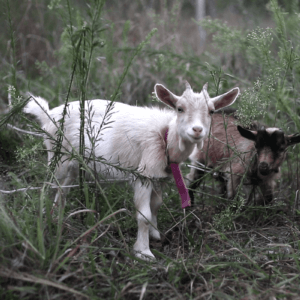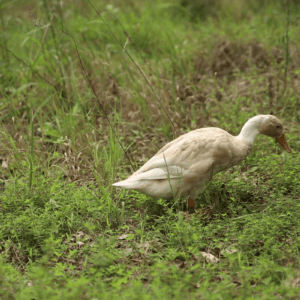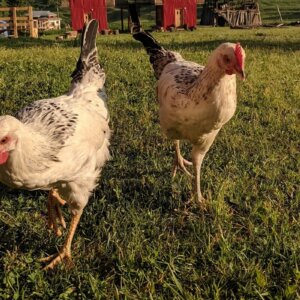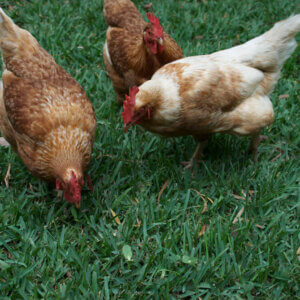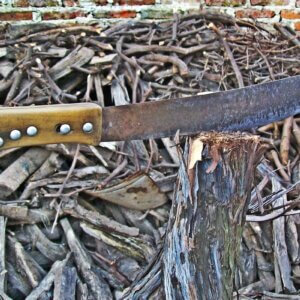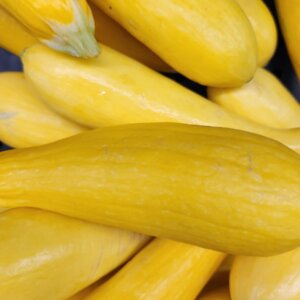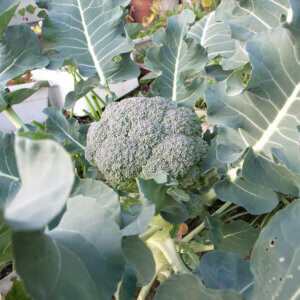- Purpose: Ornamental/Pet
- Eggs: Cream
- Egg Size: Small
- Color: 2,500 plus
- Comb Type: Single
Every animal has its superlatives: the biggest, the strongest, the rarest, and so on.
In the chicken world, the Serama holds the title of the absolute smallest … and maybe one of the most expensive, too.
This bittiest of birds is a relative newcomer to the poultry scene, having only been officially recognized for 50 years and only present in the U.S. since 2000.
After a close brush with extinction in 2004 due to a bird flu outbreak in its native Malaysia, this high-stepping breed has surged back on the scene and is ready to win your heart with the mere sight of its proudly puffed chest.
A “Living Work Of Art”
You need to see a Serama to believe it. These true bantams are not just normal chickens in extreme miniature. They take a shape truly their own. Often compared to toy soldiers, the proportions of the chicken are unique:
- A puffed-out, heart-shaped breast that almost seems to rise above the level of the head.
- Straight-down pointing wings.
- A short back and legs so their single-combed head sometimes brushes the tail feathers.
For all the world, they look like they are standing to attention, waiting for inspection.
Due to their small size, Serama are very economical on feed and consume far less every month than standard-sized chickens. They also seem to thrive on human contact, making them excellent as a pet chicken — maybe even as a therapy animal!
They have never been bred for food production or fighting which makes their aesthetic existence somewhat poetic. And artistic they are, with more than 2,500 documented colors possible! As an extra bonus to the prospective pet owner, they are supposedly quieter than other bantam breeds and quite affectionate.
A Bird Full Of Unknowns
If you’re looking to add a Serama to your flock on a whim, you’re in for a surprise. For all their positive attributes, one huge setback to this breed is its price. Whereas more common barnyard birds like a Rhode Island Red may only be $2 a chick and $10 an adult, most Serama seem to run over $100 apiece.
Granted, these prices are usually show-quality strains. If you are just wanting to add some minute flair to your flock, you might be able to find Serama chicks on your local Craigslist for a much more reasonable $20.
Serama do not breed true to size. The clutch reared by a tiny momma bird may result in a brood that grows to be bigger than her! The breed is continually being developed, so you may not know what you’ll get when breeding your own birds.
Just keep in mind that the Serama inherited a lethal trait from one of its Japanese bantam progenitors. About 25% of incubated eggs won’t be able to hatch because the chicks’ legs are so short, some of them have trouble maneuvering into hatching position. They have a very short incubation period, however. It’s just around 15 days for the smallest strains, so you’ll get more chances to produce quality birds than the average breeds.
Serama Living Conditions
Serama are not cold-tolerant and may require indoor housing if you live in a chilly environment. Some people actually keep their tiny chickens as pets, outfitting them in bitty diapers and letting them have the run of the house.
When outside, they’ll require a little extra care and attention. Though they do far less damage than a standard-sized bird, they are at risk for predation from cats, dogs, and anything that has a mind to catch them!
What’s The Yield?
These birds are roughly the size of pigeons, to give you a gauge of their size. Roosters usually reach only 12 to 20 ounces but bantam versions of this bantam (apparently that’s possible!) can be as small as 6 ounces. Females, as you may expect, are smaller, and usually reach 9 to 12 ounces with the bantam-bantam version as small as 5 ounces. Suffice it to say, these are not table birds!
Their eggs are as small as they come, no bigger than a quarter when cracked. Even though the hens are prolific layers — often producing a steady four eggs a week –you’d be hard-pressed to make a meal.
I can’t imagine anyone keeping these proud and larger-than-life birds for a food source, though. Their main use is companionship and exhibition. And for a perky, petite pet, the long-lived Serama may strut at your side for upward of 10 years!
Fun Facts
There are many variations and bloodlines of the Serama in its native Malaysia, but due to rampant fear over the Asian bird flu, no further individuals of this petite fowl have made it to the U.S. beyond the original 100 that survived being imported in 2000. All American Serama are descended from these birds.
For the record, none of the Malaysian Serama were ever found to be infected with avian flu. The culling was a government-mandated reaction to the avian flu panic of 2004. Many Serama survived because their owners hid them in the jungle to preserve the breed!
Photos of Serama Chickens
Resources
- Serama Bantams, Serama Bantams
- Malaysian Ayam Serama Chicken: The smallest Chicken in the World, Raising Chickens
- Serama Chickens: Good Things in Small Packages, Backyard Poultry
- Serama: Is This Tiny Chicken Right for Your Flock?, The Happy Chicken Coop
- Serama, My Pet Chicken
- Serama, Omlet
- Serama, Wikipedia
- Serama Chicken Characteristics & Breed Information, Roy’s Farm
- Serama Chicken Breed – Everything You Need to Know, Domestic Animal Breeds
- Raising Serama Bantam Chickens, Living the Country Life






